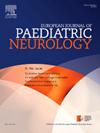Approach to childhood tremors: Insights from a pediatric neurologist
IF 2.3
3区 医学
Q3 CLINICAL NEUROLOGY
引用次数: 0
Abstract
Objective
This study aimed to analyze the demographic, clinical, and therapeutic profiles of pediatric patients diagnosed with tremor at a tertiary neurology outpatient clinic and to identify the most frequently employed therapeutic modalities.
Methods
A retrospective analysis was conducted between November 1, 2022, and April 1, 2024. Patients were categorized into etiological groups, including essential tremor, metabolic causes (e.g., vitamin deficiencies and thyroid dysfunction), functional tremor, and other etiologies. Patients diagnosed with essential tremor were further divided based on whether they were prescribed anti-tremor medications, and the groups were compared regarding daily functional abilities.
Results
A total of 192 patients were included, of whom 81 (42.1 %) were male. The mean age was 170 months, and the mean tremor duration was 19 months. Essential tremor accounted for 125 cases (65.1 %), while 38 patients (19.7 %) had a metabolic etiology. First-line anti-tremor medication (propranolol) was administered to 58 out of 125 patients (46.4 %), and four patients required second-line therapy (primidone). Between the medicated and non-medicated groups no significant gender differences or difficulty in bringing food to the mouth accurately were observed. However, significant statistical differences were noted in difficulties with drinking water, using a spoon, and handwriting impairments.
Conclusion
Childhood tremor is a common clinical condition with diverse etiologies, where treatable causes, especially vitamin deficiencies, play a significant role. Functional impairments, such as difficulty in drinking water, using a spoon, and writing, may serve as key predictors for initiating first-line anti-tremor therapy. Propranolol remains an effective therapeutic option for essential tremor in children.

儿童震颤的治疗方法:来自儿科神经学家的见解
目的:本研究旨在分析三级神经病学门诊诊断为震颤的儿科患者的人口统计学、临床和治疗概况,并确定最常用的治疗方式。方法于2022年11月1日至2024年4月1日进行回顾性分析。患者被分为病因组,包括特发性震颤、代谢原因(如维生素缺乏和甲状腺功能障碍)、功能性震颤和其他病因。诊断为特发性震颤的患者根据是否服用了抗震颤药物进一步进行了分类,并对两组患者的日常功能能力进行了比较。结果共纳入192例患者,其中男性81例(42.1%)。平均年龄170个月,平均震颤持续时间19个月。原发性震颤125例(65.1%),代谢性震颤38例(19.7%)。125例患者中有58例(46.4%)使用一线抗震颤药物(心得安),4例患者需要二线治疗(普胺酮)。在服药组和未服药组之间,没有观察到明显的性别差异或将食物准确送入口腔的困难。然而,在饮水困难、使用勺子困难和书写障碍方面,统计上存在显著差异。结论儿童震颤是一种常见的临床疾病,病因多样,其中可治疗的原因,尤其是维生素缺乏,起着重要作用。功能障碍,如饮水、使用勺子和书写困难,可能是开始一线抗震颤治疗的关键预测因素。心得安仍然是儿童特发性震颤的有效治疗选择。
本文章由计算机程序翻译,如有差异,请以英文原文为准。
求助全文
约1分钟内获得全文
求助全文
来源期刊
CiteScore
6.30
自引率
3.20%
发文量
115
审稿时长
81 days
期刊介绍:
The European Journal of Paediatric Neurology is the Official Journal of the European Paediatric Neurology Society, successor to the long-established European Federation of Child Neurology Societies.
Under the guidance of a prestigious International editorial board, this multi-disciplinary journal publishes exciting clinical and experimental research in this rapidly expanding field. High quality papers written by leading experts encompass all the major diseases including epilepsy, movement disorders, neuromuscular disorders, neurodegenerative disorders and intellectual disability.
Other exciting highlights include articles on brain imaging and neonatal neurology, and the publication of regularly updated tables relating to the main groups of disorders.

 求助内容:
求助内容: 应助结果提醒方式:
应助结果提醒方式:


